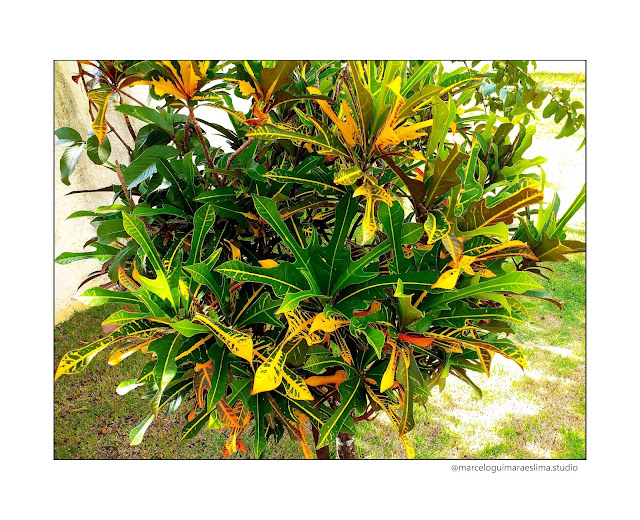HORTUS ABSCONDITUS
Marcelo Guimarães Lima
Hortus Absconditus I, 2021
Hortus Absconditus
Marcelo Guimarães Lima
The garden is the ordering of nature by culture. Alois Riegl defined art as a disputation of man with nature. The form giving processes of nature constituted to the Austrian art historian both a model and a challenge to art. To Riegl, such a relationship, at the same time adaptive and competitive , between the work of art and nature, implied no simple “naturalism”, the reproduction of natural appearances, but demanded always a distillation and recreation of our perceptual actions and our productive formal capacities in contact with and in contrast to the natural world of forms.
The “will to form” proper to art, expresses spiritual freedom within material conditions and therefore it states a kind of differential “equality” between the powers of nature and that of our own creative capacities.
Marcelo Guimarães Lima
Natura Naturans - Natura Naturata
drawing and photograph, 2021
Natura Naturans - Natura Naturata
drawing and photograph, 2021
As Hegel had observed, the commonly conceived ways from the order of nature to the order of art, was in fact a type of popular misconception: it was indeed art, according to Hegel, that taught mankind to appreciate beauty, that is, harmony in the domains of nature by imposing spiritual marks on the raw elements of a multifarious reality.
Marcelo Guimarães Lima
The Red Garden
digital drawing, 2021
The garden as an ordered space establishes a boundary interrupting the spatial continuity, the flow of natural elements and processes in reality and in this way, changes our contextual experiences of both space and time. A boundary, that is, a line separating inner and outer spaces, an imaginary construct delineating a field of intervention, establishing productive imagination within the fabric of the real.
Marcelo Guimarães Lima,
Flora Obscura II - Dark Garden,
digital drawing, 2021
digital drawing, 2021
Gardens have provided symbolic references related to human powers, to the powers of nature, as representations of both active and adaptive behaviors, the shaping of the natural world as a duplication of nature, as the symbolic space of a paradigmatic social order, mixing ideological and utopian perspectives, or as manifestation of a transcendental reality made visible and palpable, that is, the earthly embodiment of a celestial, divine order.
Marcelo Guimarães Lima
Blue Garden / Jardim Azul
digital painting, 2021
digital painting, 2021
Gardens have been appreciated as the expression of the energies of the human heart, as in the romantic garden (and its mannerist prefigurations), and also as the expression of the immanent order of the subject: the garden as a meditative space, as mirror for the soul, as objectification and representation of emotional states and energies, and as such, as guide for the subject´s search for inner harmonies.
Marcelo Guimarães Lima,
Nova Flora, 2021
Marcelo Guimarães Lima,
Intra Muros, 2021
Marcelo Guimarães Lima
Hidden Garden series / Jardim Oculto
digital painting, 21x29cm
2023
The garden brings together the physical world and the mind, it both constructs and discloses relationships in reality, it promotes and models adaptive actions in a common context that relates the rational, as a system of efficient means, and the ethical: the ordering of nature in gardening reflects back as the self-productive ordering of the subject.
In this hall of mirrors, the material space of the garden can be said to point out towards the inner source of order within the subject, that is, to the subject´s recognition of world and self as a unity in difference. An idea that can be said also to express a final recognition of the garden as type of perennial hortus absconditus, a hidden region of the real to be discovered and rediscovered at different times in the quest for inner and outer harmony as process, as labor that must renew itself in the model of the recurring works of nature.
Marcelo Guimarães Lima,
Hidden Garden, pencil on paper,
21x29cm (paper size), 2021
The present series of visual works, drawings and photographs, depict a specific enclosure, a simple domestic garden as a kind of territory being mapped by different kinds of artworks, an actual, an everyday enclosed place turned into a type of graphic stage of artistic records and intervention. Walls are frames organizing a given portion of reality echoing the total, self-contained and communicative space of the work of art.
Marcelo Guimarães Lima
Hortus Absconditus IV, 2021
Marcelo Guimarães Lima,
Microflora, 2021
Marcelo Guimarães Lima,
Guardian, 2021
That the space of the work of art is a kind of infinity within itself is perhaps better stated by the words of Pascal describing the extension of a given universe as "a circle whose center is everywhere and whose circumference is nowhere". In its modest, at times precarious material reality, made of traces, ephemeral gestures, memories and desires, and in the depths of its multidimensional reality, the work of art is always, as Claude Lévi-Strauss observed, a reduced model of the universe. By tracing a line, defining a surface and creating a figure, the gardener is the father of the artist.
December, 2021
Marcelo Guimarães Lima
Hortus Absconditus III,
digital drawing, 2021
digital drawing, 2021
(c) Marcelo Guimarães Lima















Comentários
Postar um comentário